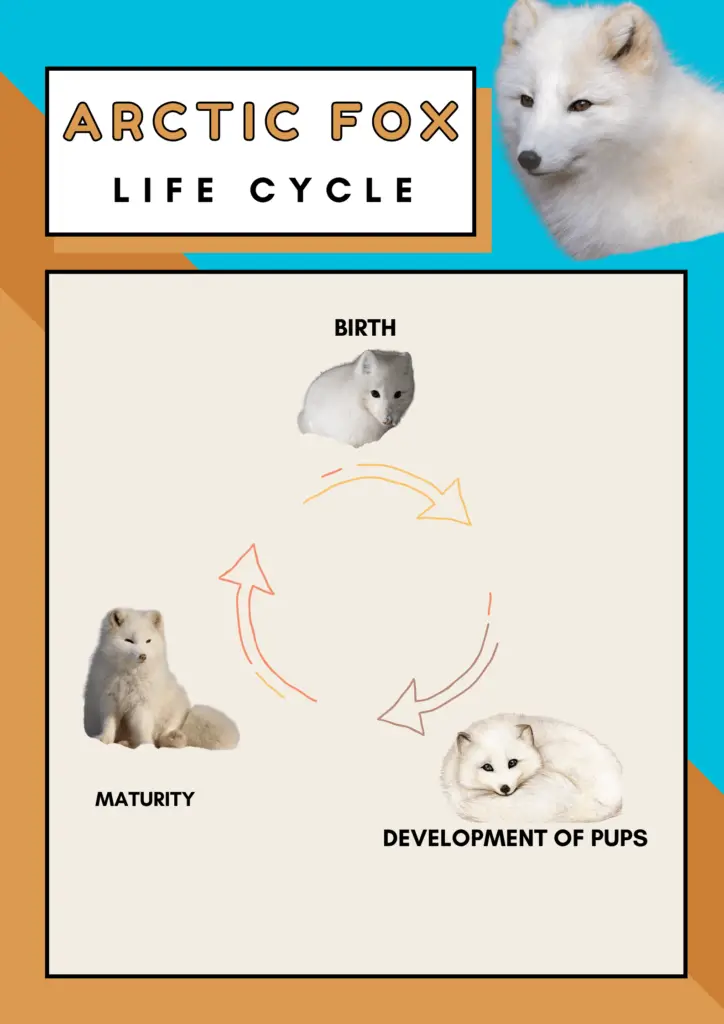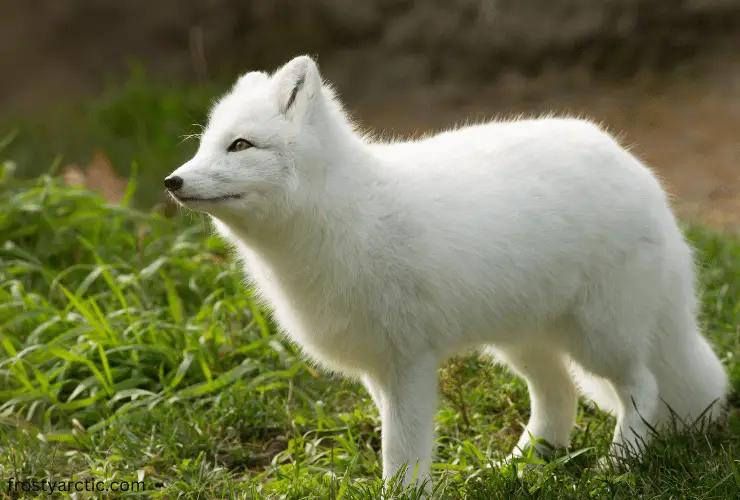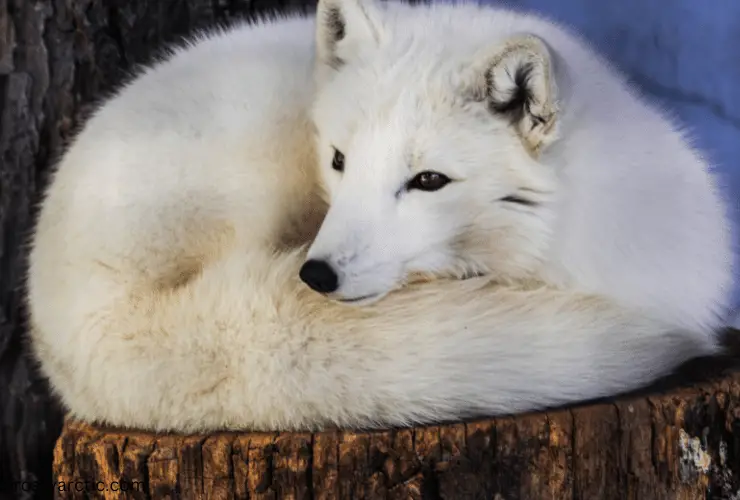The Arctic fox life cycle consists of several stages. They are born between April and June. Both parents and another family member help raise the young until they are ready to hunt independently. If they survive, these animals reach sexual maturity at nine months old and are ready to reproduce.
There is more to Arctic foxes than their color-changing fur. This article investigates these animals’ unique lifestyles, adaptations, and developmental stages. So, without further ado, let’s get started!
How Long Do Arctic Foxes Live?
Arctic foxes generally don’t have a very long lifespan. The oldest recorded Arctic fox is about 11 years old.
What is an Arctic fox’s lifespan?
After making it to adulthood, the average lifespan of Arctic foxes is approximately 3 years on average. ~ P. Hersteinsson, (unpubl)
Their low mortality rate is linked to the fluctuation in the lemming population and the competition for prey among Arctic and Red foxes.
Because of global warming, red foxes are gradually outnumbering arctic foxes, taking over their limited food supply or even hunting them in most cases. ~ Source

Global warming has also reduced the effectiveness of the iconic Arctic fox camouflage, making them vulnerable to predator attacks.
Arctic foxes are heavily reliant on lemmings for food. So, when the lemming population fluctuates, Arctic foxes suffer from starvation which might even be fatal.
Arctic Fox Life Cycle Information: Arctic Fox Life Cycle Stages
1. Birth
Arctic foxes breed from early September to early May. The number of offspring depends on how much food is available.
Arctic foxes give birth to the first litter from April to June, and during July and August, the second litter is born.
A female fox may give birth to 5 to 8 kits on average. After birth, the weaning period begins. These creatures work in teams to raise their offspring.
The females stay close to their mothers even after breeding. On the birth of their young ones, they return to their mothers to help raise the young. ~ Source
Both males and females help raise offspring. The male hunts for food and returns it to the den to feed the young.
2. Development of Pups
A study conducted on Arctic fox pups found cannibalistic behavior among pups, especially in times of food scarcity. ~ Source
After a period of two to four weeks, the kits are ready to leave their dens.
These tiny animals can now hunt for themselves and range away from their dens independently. Pups start to eat meat when they turn one month old.
During September and October, family units start to break apart. This is the time when most foxes stay independent and only get together when feeding the carcasses of reindeer or marine mammals.
3. Maturity
Arctic foxes reach sexual maturity at about 9 or 10 months old. Most of them die in the first year of their life. ~ ADFG.Alaska.gov
Their diet consists of small mammals such as lemmings and tundra voles in the summer months. During the winter, foxes move to the sea ice to feed on the leftovers of polar bears.
Do Arctic Foxes Mate for Life? When A Pair of Arctic Fox Mate?
Arctic foxes are monogamous, which means they mate for life. The mating season for these animals is quite long, i.e., from September through May(next year). ~ Source
During the breeding season, these animals form monogamous pairs and give birth between April and July. the gestation period lasts almost 52 days (or four to five weeks).
If the prey is abundant, Arctic foxes might breed again and give birth to a second litter in the same year. ~ (McGonigal, 2001)
Why Do Foxes Scream When Mating?
Research suggests that foxes scream to find prospective mating partners. It is not just their mating call; female foxes (also called vixens) scream during mating.
Foxes are nocturnal animals and hunt for food at night. However, these animals can often be heard screaming to attract mates during the mating season.

In January, the mating season is at its peak. This is when most female foxes scream to let a male fox know she is ready to mate. The male answers her mating call with a bark.
The screaming sound of a fox is one way of warning other foxes of the presence of a predator. They might also use their unique scream to communicate with fellow foxes.
Male foxes have been found to scream on various occasions. Aggressive males use short and explosive screams to warn rivals to avoid its mate. ~ Source
What Happens After an Arctic Fox Dies?
The extinction of Arctic foxes impacts both their prey and their predators. Therefore, after Arctic foxes die, the ecosystem of the Arctic regions where they live is altered and negatively affected.
If Arctic foxes go extinct, their prey (including lemmings, voles, birds, and fish) might overpopulate the Arctic tundra because their survival rates would increase drastically.
On the other hand, animals such as polar bears, bald eagles, red foxes, and golden eagles who prey on Arctic foxes will no longer have sufficient food to eat.
This could lead to starvation which could decrease their survival rates.
Did you know? The Arctic fox population in the southern part of the Arctic tundra has slowly declined. They have retreated northward due to dramatic climate changes that threaten their lives. ~ Biological Diversity.org
What Are Baby Arctic Foxes Called?
Baby arctic foxes are called pups or kits and are covered in velvety dark brown fur. After two weeks, the fur increases in length and becomes lighter in the shade.
As the pups become three months old, the back darkens and the difference in the shade of the belly and the back becomes more evident.
On the other hand, the blue-colored pups acquire their iconic dark color at two months old.
Do Female Foxes Stay Single If Their Mate Dies?
When their mate dies, female foxes immediately start looking for another mate and will produce a litter for the rest of their life.
On the other hand, if the vixen (female fox) dies, the male will stay single for the rest of his life.
Did you know? Females from previous litters sometimes help raise the new litter. ~ Source
Do Foxes Fall in Love?
Scientifically speaking, animals experience emotions such as empathy, affection, and attachment. So, foxes can fall in love. Foxes are clever creatures, but they are also very loving.
The courtship ritual of Arctic foxes is very interesting. It involves play time between males and females, during which they run around together while nipping each other affectionately. ~ Source
Are Arctic Foxes Smart?
Yes, Arctic foxes are pretty smart and intelligent animals, especially if one investigates their lifestyle, including the following points:
- Eating habits
- Survival in the arctic tundra, and
- Protection of their young.
Do you know arctic foxes are familiar as trick masters in many books and stories? Due to their smart behavior, people often use the phrase ‘clever like a fox’ to demonstrate cleverness.
The animals are opportunistic feeders. Because prey is scarce in the Arctic tundra, the animals opt for any small mammals they can find.

They will trail behind polar bears to eat their leftovers if no food is available. They hide in such a way that polar bears barely detect their presence near them, which shows how smart they are.
Their way of life also shows how smart these creatures are. Arctic foxes live in a complex network of tunnels under the snow. These “dens” keep them hidden from predators and help them protect their young.
Some Moral points that prove their smartness and intelligence:
- The iris of its eyes is an orange-yellow or deep golden color, which is helpful against the glare in the icy Arctic environment.
- Their pupils are vertical like a cat, enabling them to see prey at night.
- A special point that proves them smart or intelligent is their hearing power. It can hear a single ticking of a watch 40 yards away.
- Their average running speed is 45 MPH (even though they are small in size).
Can Arctic Fox Laugh?
Yes, according to a short video posted on social media, Arctic foxes can laugh. However, one must note that human emotional states cannot always be applied to animals.
The video shows an Arctic fox named Archer producing a wide range of sounds, including howls and high-pitched noises that sound like laughter.
Rob Halpin of MSPCA-Angell states this behavior is closest to “laughter.”
Research has shown that happiness tends to be a universal emotion that is common in animals too.
Note: Archer is a victim of the exotic pet trade. ~ Source
What Are The Arctic Foxes’ Biggest Threat?
The biggest threat to Arctic foxes nowadays is global warming which has caused the snow to melt. Consequently, the iconic fur of Arctic foxes is no longer effective in hiding them from predators.
Because of the melting snow, the red fox population is expanding Northward, taking over the habitat of Arctic foxes. This migration also increases the competition for prey among the two animals. ~ Source
Because of ineffective camouflage, the foxes cannot hunt as effectively. Plus, the lemming population is shrinking in their habitat. Hence, they might die due to starvation.
Global warming has led to the loss of sea ice and the shrinking of the Arctic fox habitat, a major threat to the Arctic fox population.
FAQs:
Are arctic foxes born blind?
Yes, Arctic foxes are born blind and open their eyes after at least twelve days.
Do arctic foxes turn black?
During summer, they take on a dark or light grey tone (almost black), while in the winter, they are covered in a white coat.
Why do arctic foxes change color?
Arctic foxes shed their fur as the season changes. It allows them to blend in with their surroundings and hide from predators and prey.
Conclusion
Arctic foxes are pretty smart animals, from their biological characteristics that protect them against the biting cold of the tundra to the behavioral adaptations that help them survive.
I hope this article helped explain the Arctic fox life cycle effectively and unveil their unique lifestyles.



1 thought on “What is An Arctic Fox’s Life Cycle? ”